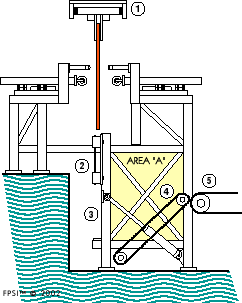Counterbalance valves are among the top subjects viewed week after week on our website. I don’t know why, so your guess is as good as mine.
Counterbalance valves are safety devices that prevent a load from dropping if pressure is lost in the line feeding a cylinder. They allow free flow into a cylinder, but block reverse flow unless pressure inversely proportional to the load exists in the valve’s pilot line. You could use a pilot-operated check valve instead, but the proportional nature of the counterbalance valve maintains smooth motion of the cylinder’s piston as it retracts. With a P-O check, on the other hand, the cylinder’s piston rod may “chatter” as it retracts.
So counterbalance valves are useful and popular safety devices. But Rory McLaren of the Fluid Power Safety Institute (FPSI) says they can be deceptive by trapping pressurized fluid within the line between the cylinder and directional valve. A scenario is explained in a safety alert on his website, www.fluidpowersafety.com.
A rod seal on a vertically mounted hydraulic cylinder was leaking, and to work on the cylinder, a mechanic followed what he thought were all the necessary safety precautions. He shifted the directional valve to fully lower the load, de-energized the hydraulic power unit, and locked the power unit out according to company policy. He then loosened the fitting on the cap-end of the cylinder, and, to his surprise, a high-velocity jet of hydraulic fluid shot out of the fitting.
The mechanic assumed that lowering the load to a rest position dissipated all pressure in the hydraulic line he was working on. Sounds logical to me. But McLaren explains that a counterbalance valve in the line between a cylinder and directional control valve can become a pressure trap. Consequently, the pressure setting of the counterbalance valve is the lowest pressure in the line when the machine is shut off—even if the cylinder is at the rest position.
In this case, the pressure setting of the counterbalance valve was 1200 psi (83 bar)—more than enough stored energy to launch a lethal shot of oil. The mechanic was injured by the accident—and could’ve been killed. What he should have done was verify that all hydraulic lines were depressurized before opening any of them to atmosphere.
Suggestions on how to prevent this type of accident*
1. Make safe and verifiable de-energization the focus of system design. The design must include a means of safely removing any and all "pockets" of potentially hazardous hydraulic energy, Figure A. In addition, if a possibility exists for re-accumulation of stored energy to a hazardous level, continue verification of isolation until the servicing or maintenance is completed or until the possibility of such accumulation no longer exists.
2. Install a suitable product such as Safe-T-Bleed, which is designed specifically for the purpose of bringing a hydraulic system into compliance with OSHA's lockout standard.
3. Make lockout and de-energization training mandatory for all personnel who work on and around hydraulic systems — people who work on and around hydraulic systems must understand how and why hydraulic systems store energy.
4. Write a Job-Safety-Breakdown (JSB) for locking out and de-energizing hydraulic machines — good written communication is vital to support and reinforce verbal communication.
5. Have lockout and de-energization drills to ensure that personnel know exactly how to make a machine safe to work on; some lockout situations are complex because someone might need to lock out numerous machines to make the situation safe. Refer to Figure B, which illustrates an actual machine. Routine maintenance and repair have to be carried out in area A. To lock the machine out safely, it is necessary to lockout mechanisms 1, 2, 3, 4, and 5 individually. Failure to do so could result in severe injury or death. It would be wise to have periodic lockout drills on these types of machines. Telling maintenance and service personnel how to conduct the service or repair in a classroom setting is one thing, doing it under the demanding pressures of a disabled production machine is another. When it comes to safe lockout, there is absolutely no room for error!
6. Make the "cracking" of connectors to remove stored energy a serious safety violation, and punish those who do it accordingly.
7. If a hydraulic machine is not designed to facilitate safe de-energization and verification, don't risk your life. Call the respective machine manufacturer for help. If you are told to crack a connector, refuse — it could kill you!
8. When purchasing or specifying hydraulic machinery or equipment, ask the supplier or manufacturer, if it complies with OSHA's standard for lockout with respect to safe de-energization and verification. If it does not, make the purchase of that machinery or equipment subject to compliance.
9. Contractors must obey your safety rules. In many cases, untrained service and repair personnel who are hired to work on your hydraulic machines do not follow good safety practices. In many cases, they have absolutely no training themselves. Ask about employee training and certification before hiring a contractor. Outside contractors are looked upon by your employees as experts. They are generally called upon to do either warranty work or because your personnel are not qualified to do the work themselves. If they are going to mentor your personnel, it is critical that they lead by example, especially when it comes to safety.
Conclusion
All hydraulic machines must be designed and built to comply with OSHA's standard for lockout with respect to safe and verifiable de-energization — otherwise, they are simply unsafe!
If, in the course of your work, you have to open a hydraulic system, and you find that you cannot safely de-energize the system or verify if the system is de-energized, never guess! Call the manufacturer and ask for guidance.
Oil escaping to atmosphere at high velocity can easily penetrate your skin. Skin penetration injuries have been recognized as devastating and can result in severe injury or death.
*This information was excerpted from this page on the Fluid Power safety Institute website.



